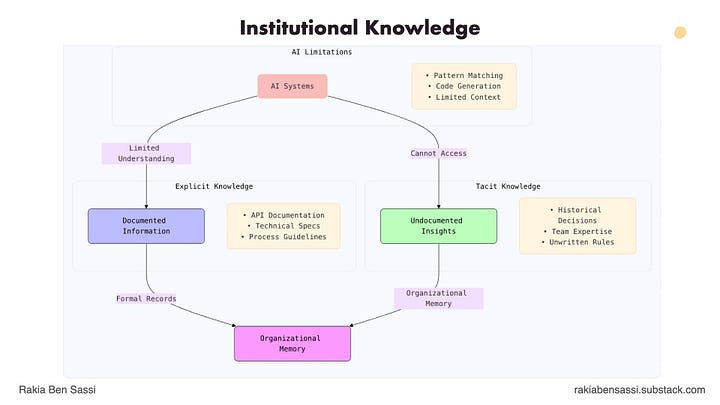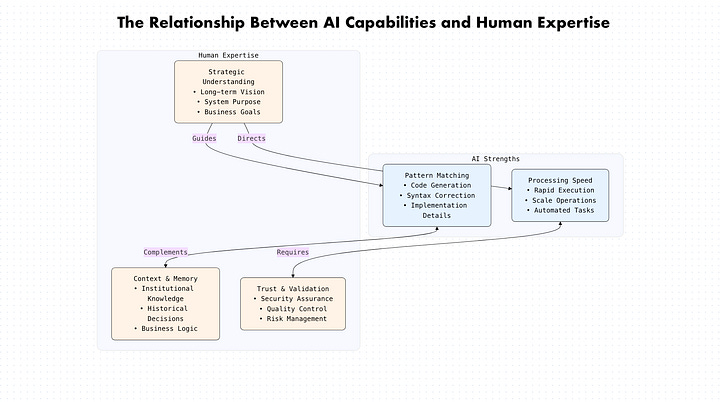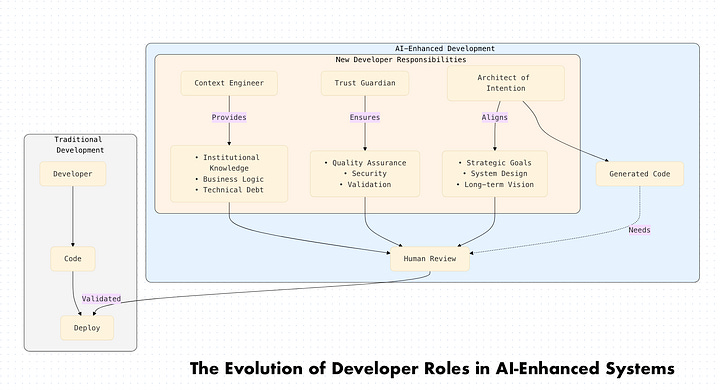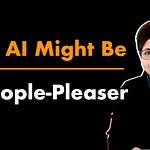Let me ask you a quick question. An AI generates a perfectly functional, efficient sorting algorithm. The code is clean, it’s fast, it’s flawless. Does this demonstrate the AI’s…
A) Wisdom?
B) Understanding?
…or C) Intelligence?
Think about your answer. Lock it in. We’re going to come back to this at the end. Because the massive gap between those three words is the most misunderstood, and most profitable, opportunity in technology right now.
We are so mesmerized by the magic trick of code generation that we’re completely missing where the real, durable value is. I’ll give you a hint: it’s not in the AI.
Your company’s most valuable asset isn’t your AI. It’s the stuff your AI can’t read.
You know the person. The one developer who’s been there for a decade. The walking, talking single point of failure, who knows why the billing API uses a strange authentication method from 2016, or why touching a specific legacy service will bring the entire system to its knees.
When that person leaves, a part of your company’s brain walks out the door with them.
For years, we’ve been promised that AI would solve this. We’ve been sold a future where intelligent systems absorb all our knowledge and keep the engine running flawlessly. But as we stand here in late 2025, a stunning and dangerous reality is setting in: Companies are spending billions on AI that can write code at the speed of light, but they’re building it on a foundation of organizational amnesia.
The problem is that we’re asking the wrong question. We’re obsessed with the AI’s IQ, when we should be obsessed with its memory. And its biggest weakness is that it has none.
AI’s Achilles’ Heel: The Context Blind Spot
I want you to look closely at this first diagram. It reveals the fundamental limitation of every AI system on the market today.
AI systems are phenomenal at consuming Explicit Knowledge — the clean, documented information in your API docs, technical specs, and process guidelines. They can generate code, find patterns, and summarize information from these formal records.
But they are completely blind to Tacit Knowledge.
This is the ghost in your machine. It’s the wealth of undocumented insights, historical decisions, team expertise, and unwritten rules that actually dictate how your business operates. It’s the “why” behind the “what.” AI has no access to this organizational memory.
It doesn’t remember a requirement buried in a ten-year-old Jira ticket or a hallway conversation that redefined “active user” three years ago. It doesn’t understand the political reasons why a certain project was sidelined.
Without this context, AI is a brilliant intern with amnesia. It can follow instructions perfectly, but it has no idea why the instructions exist in the first place. And as any experienced leader knows, operating without the “why” isn’t just inefficient — it’s catastrophic.
The Real Relationship: AI is the Engine, You Are the GPS
This brings us to the most critical strategic shift you need to make. Stop thinking about AI as a replacement for human intelligence. Start thinking of it as a force multiplier for human expertise.
The relationship isn’t one of opposition; it’s one of symbiosis.
As you can see, AI’s strengths — pattern matching, code generation, speed — are tactical. They are raw processing power. Human Expertise, on the other hand, is strategic. Your long-term vision, understanding of business goals, and grasp of the system’s core purpose are what guide and direct that raw power.
Notice how human-provided Context and Memory are what complement the AI’s pattern matching. Your understanding of past decisions is the filter that makes the AI’s output relevant. Your ability to provide Trust and Validation through security assurance and quality control is what makes the AI’s output safe.
Studies confirm this. Organizations achieving the highest ROI from AI are not those with the most powerful models, but those who have most effectively integrated their models with deep institutional knowledge and human oversight.
They’re not fixing the AI; they’re fixing the architecture around the AI.
Your New Job Title: Architect of Intention
So, what does this mean for you, the developer?
Your traditional “Developer -> Code -> Deploy” workflow is dead. Welcome to the era of AI-Enhanced Development.
This new workflow requires a separation of concerns, creating three specialized and indispensable roles for humans:
The Context Engineer: You are the memory-keeper. Your job is to feed the AI the essential institutional knowledge, business logic, and warnings about technical debt it needs to generate relevant code. You are the AI’s link to the company’s past.
The Trust Guardian: You are the validator. Your role is to ensure the quality, security, and integrity of the AI-generated code. You perform the critical human review, asking, “Is this secure? Is this reliable? Does this meet our standards?” You are the AI’s conscience.
The Architect of Intention: You are the visionary. You align the AI’s output with the company’s strategic goals, system design, and long-term vision. You hold the blueprint and ensure every piece of generated code serves the ultimate purpose. You are the AI’s soul.
These aren’t just fancy titles. They represent the fundamental shift from writing lines of code to orchestrating intelligent systems.
The 9 Skills That Will Define Your Career in 2026
If you want to thrive in this new reality, you need to start cultivating the skills that AI can’t replicate. It’s not about becoming a better coder; it’s about becoming a better thinker, strategist, and partner to your new AI tools.
Look at this list from Bob Violino’s article “9 AI development skills tech companies want.”
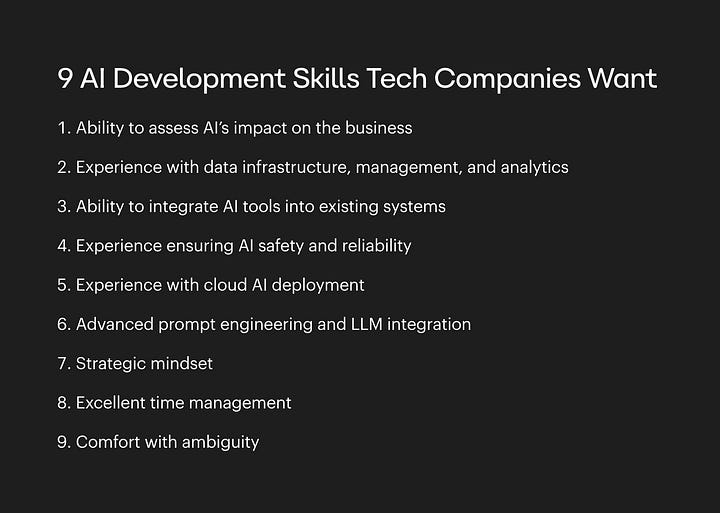
Skills like “Ability to assess AI’s impact on the business,” “Strategic mindset,” and “Comfort with ambiguity” are no longer soft skills — they are the core competencies of the modern developer. Advanced prompt engineering and LLM integration are the new syntax, while experience with data infrastructure and AI safety are the new foundations.
Analytical and creative thinking are the fastest-growing skills required across all industries, precisely because they are the domain of human intelligence.
The ultimate competitive advantage in the age of AI is no longer your tech stack. It’s your people and the collective knowledge they hold. Stop chasing the next large language model and start building a culture that documents, shares, and leverages your unique organizational memory.
Because the future doesn’t belong to the company with the best AI. It belongs to the company with the smartest humans directing it.
And that brings us right back to the question from the beginning. The AI generates that flawless sorting algorithm. What did it actually demonstrate? Was it A, Wisdom? B, Understanding? Or C, Intelligence?
The correct answer is C. Intelligence.
And the difference between these words is everything.
Intelligence is knowing how to perform a task. The AI showed pure, raw, computational intelligence. It knows how to sort a list perfectly. It’s a tactical masterpiece. But what it completely lacks is Wisdom.
This is the core distinction:
Intelligence is knowing how to sort a list. Wisdom is knowing why you shouldn’t be sorting a 10-terabyte list in-memory, on the main thread, during peak traffic.
Intelligence is knowing how to build a login form. Wisdom is knowing why your specific application requires biometric authentication instead.
AI has the first in spades. It’s absolutely, fundamentally clueless about the second. That wisdom… that is institutional knowledge. That’s the context from the Context Engineer, the validation from the Trust Guardian, and the strategic vision from the Architect of Intention. That is your new job.
So let the AI be the intelligent tool. Your job is to be the wise architect.
If this changed the way you think about AI and your career, let me know in the comments which of the new developer roles you see yourself in. Stay sharp, and I’ll see you in the next one.
Cheers,
Rakia
🎁 I deliver bespoke tech workshops and seminars that:
✨ Make complex topics exciting
✨ Show real-world case studies
✨ Give hands-on with tailored content
✨ Let you leave energized 🚀 not overwhelmed!
Want this energy for yourself or YOUR team? 👉 Reach out or DM me.
Further Reading and Viewing
🎥 Agentic AI Coding, Next-Gen Models & Prompt Engineering Explained
📖 Agentic AI Coding, Next-Gen Models & Prompt Engineering Explained
🎁 Special Gift for You
I’ve got a couple of great offers to help you go even deeper. FREE access to my video courses - available for a limited time, so don’t wait too long!
🔥 Modern Software Engineering: Architecture, Cloud & Security
FREE coupon RAKIA_SOFT_ENG_5🤖 The AI for Software Engineering Bootcamp 2025
FREE coupon AI_ASSISTED_ENG_5🔐 Secure Software Development: Principles, Design, and Gen-AI
FREE coupon RAKIA_SECURE_APPS_5FREE coupon RAKIA_API_DESIGN_5
🐳 Getting Started with Docker & Kubernetes + Hands-On
FREE coupon RAKIA_DOCKER_K8S_5⚡ Master Web Performance: From Novice to Expert
FREE coupon RAKIA_WEB_PERF_5
Want more?
💡 🧠 I share content about engineering, technology, and leadership for a community of smart, curious people. For more insights and tech updates, join my newsletter and subscribe to my YouTube channel.


